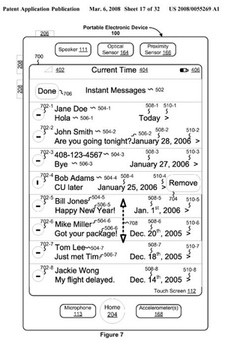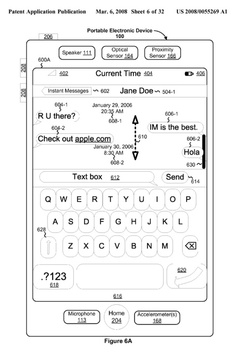 From Day 1 of the iPhone’s existence, users have clamored for a real-time instant message client like iChat. Instead, they’ve been given a sub-par intermediate solution — SMS through the exclusive iPhone carrier network, AT&T.
From Day 1 of the iPhone’s existence, users have clamored for a real-time instant message client like iChat. Instead, they’ve been given a sub-par intermediate solution — SMS through the exclusive iPhone carrier network, AT&T.
When Apple announced its software developers kit (SDK) will be available for third-party application development in June, those who covet an iPhone IM client rejoiced, crossing and recrossing their fingers in hope.
On Tuesday, AppleInsider noted that Apple applied for a patent last August on a universal interface for a real-time chat service on the iPhone. The patent was recently published in March.
The patent details what the IM client would look like and how it would behave on the iPhone. Judging by images that accompany the patent, IM will look like the current SMS program and also be a bit iChat-esque.
When I heard of the patent, I wondered why Apple just didn’t wait for others to develop their own third-party IM clients — AOL for AIM, Google for Gtalk, Yahoo! for Messenger, and others. The answers I came up with were:
- control of the user experience
- that the technology needed to do an IM client the right way — the way we all expect it to behave — is just not there yet for the iPhone
- and because of this, Apple is needing to make significant changes to the iPhone architecture to allow for, among other things, applications to function independently in the background.
 Currently on the iPhone, you can use a Web-based IM client to access any of the messaging services. But when you answer a call, check your email, or hop on the Web — even for a moment — your IM connection is lost. It’s painfully frustrating and the reason why I don’t even bother, relying instead on the iPhone’s SMS service through AT&T.
Currently on the iPhone, you can use a Web-based IM client to access any of the messaging services. But when you answer a call, check your email, or hop on the Web — even for a moment — your IM connection is lost. It’s painfully frustrating and the reason why I don’t even bother, relying instead on the iPhone’s SMS service through AT&T.
Like many other iPhone users, I resent having to use AT&T’s SMS service exclusively, but it’s a necessary evil — as long as I keep my IMs to less than 200 a month. Believe me, that’s hard.
I’ve always believed that true IM will come to the iPhone in time, as will the ability to run multiple applications in the background. But from what I understand, this is not a part of the forthcoming SDK.
So something more significant than real-time IM on the iPhone is going on here. Apple hints in the patent that “graphics, photos, audio files, video files and/or other attachments are supported in a MMS and/or Enhanced Message Service,” which points to future MMS support. Unlike multimedia phones on the market, the iPhone does not support MMS functions like sending photos from one phone to another.
In the patent there is also a reference to the user receiving “an instant message while the user of the device is in another application.”
Bingo.
Progress is being made, and it means more than IM on the iPhone.
Note
I am not a mobile phone programmer, although I’ve worked with some developers during the design and engineering of various cell phones over the years. I was reminded of the process — and, more to the point, what’s going on with iPhone third-party application development — by developer Jerry Schuman, who appeared on the March 26, 2008 recording of Steve Gillmor’s daily NewsGang podcast.
Shuman detailed what it takes to get multiple applications to run at the same time on the iPhone, how these apps would be constantly calling to the network to get email, IM, and Twitter-like updates, and how all this activity would drain the battery “in a heartbeat”. Additionally, running several programs at once in the background could tax the iPhone’s processor, slowing it enough that it negatively impacts the user experience — and you know how Apple feels about that.
Shuman’s comments begin about 45 minutes into the podcast and cover the iPhone, developing applications for Verizon, and other mobile topics.
The iPhone’s advanced functionality “will come in the next couple of revs and it will be exponentially that much better,” Schuman commented. “At some point we will get to the right types of mechanisms and the right type of batteries” to make the iPhone even more “compelling” and a “significant platform that has never existed in the mobile space.”
Screenshots of Apple IM interface: Gizmodo

Another reason Apple may be developing IM now is to give Android-based phones less of an advantage once they appear. The Android SDK has been out for a while now and from what I’ve read, instant messaging seems more at home on Android. However, I do understand that the same hardware restrictions would apply if the processor/batteries are not up to scratch.